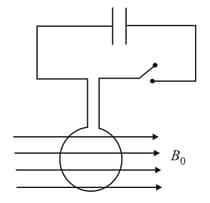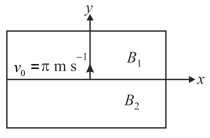A steady current flows along an infinitely long hollow cylindrical conductor of radius . This cylinder is placed co-axially inside an infinite solenoid of radius . The solenoid has turns per unit length and carries a steady current . Consider a point at a distance from the common axis. The correct statement(s) is(are):

Important Questions on Magnetic Effects of Current and Magnetism
A circular coil of radius and turns has negligible resistance. As shown in the schematic figure, its two ends are connected to two wires and it is hanging by those wires with its plane being vertical. The wires are connected to a capacitor with charge through a switch. The coil is in a horizontal uniform magnetic field parallel to the plane of the coil. When the switch is closed, the capacitor gets discharged through the coil in a very short time. By the time the capacitor is discharged fully, magnitude of the angular momentum gained by the coil will be (assume that the discharge time is so short that the coil has hardly rotated during this time)


| Column 1 | Column 2 | Column 3 |
| 1. Electron with | (i) | (P) |
| 2. Electron with | (ii) | (Q) |
| 3.Proton with | (iii) | (R) |
| 4. Proton with | (iv) | (S) |
| Column 1 | Column 2 | Column 3 |
| 1. Electron with | (i) | (P) |
| 2. Electron with | (ii) | (Q) |
| 3.Proton with | (iii) | (R) |
| 4. Proton with | (iv) | (S) |
In which case will the particle describe a helical path with axis along positive z direction?
| Column 1 | Column 2 | Column 3 |
| 1. Electron with | (i) | (P) |
| 2. Electron with | (ii) | (Q) |
| 3.Proton with | (iii) | (R) |
| 4. Proton with | (iv) | (S) |
In which case would the particle move in a straight line along the negative direction of y axis
